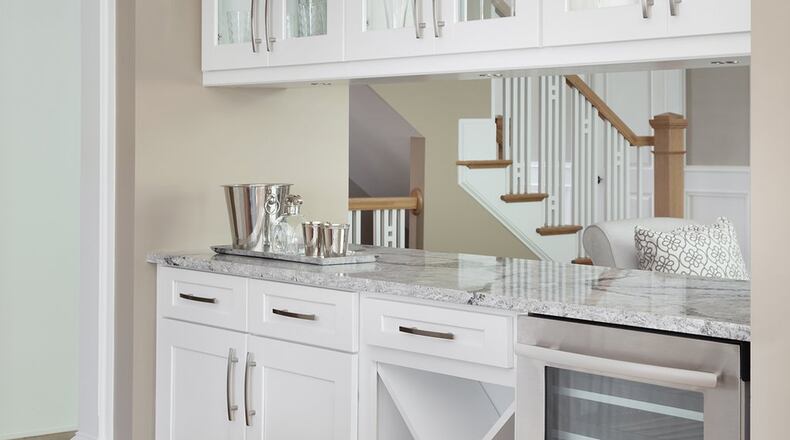If it hasn’t already kicked off, the holiday season of family and coworker get-togethers is about to shift into high gear. For those who find themselves hosting the party, there’s one built-in amenity that becomes a focal point. A beverage bar – be it a wine refrigerator, a well-stocked bar or a coffee station – helps keep the crowd circulating out of the kitchen and prep area.
The idea of including beverage stations in floor plans isn’t new, but they’re finding more favor today because their practicality extends into the rest of the year, even when it’s just the family at home. In some rooms, they’ve become fairly standard, said Leigh Spicher, director of Design Studios for Ashton Woods builders.
“For instance, a lot of our homes have basements, and they all have a wet bar,” she said. “The pool tables and game rooms are still around, but we’re seeing those areas shift toward being more of a family living space. Then those beverage bars become a little more elaborate, almost like a kitchenette with a sink and dishwasher, because they’re convenient.”
And once homeowners start thinking about convenience, they want to have beverage access in other areas as well.
“My favorite application is seeing these beverage bars in a master bedroom suite,” said Spicher. “Sometimes it’s because the bedroom is on the second story, and the owners want the luxury of not having to go downstairs for coffee before jumping in the shower.”
A bedroom beverage bar can be as simple as a side table with a coffeemaker plugged in or a built-in with storage for coffee mugs, plates and condiments. “There might even be a lower portion with a wine fridge; we have that in several of our newer model homes, and homeowners are requesting them,” said Spicher. “Just envision where you might put a bookcase; the coffee bar is almost like another piece of furniture.”
Spicher has had owners ask for coffee bars inside their large walk-in pantries, too. And they’re not scrimping just because the space is out of sight, she added. “It’s still furnished like it’s on display for guests, but the best thing is it frees up countertop space in the main kitchen.”
One reason such stations are popular is due to their cost. Though the design varies by plan, Spicher said adding a coffee beverage bar can be as low as $500. Add cabinetry, granite or quartz counter tops and a built-in system by Keurig or Jenn-Air, which recently introduced a system that doesn’t require a water line, and the price can climb into the $2,500 range. “It’s definitely a luxury that’s not that expensive,” said Spicher.
Convenience is also shifting the way people store and access wine. While palatial homes may have room for a full-scale, temperature controlled cellar, most homeowners opt to have a something closer to the main living area. Serving bars complete with mini-fridges and several storage bins are one option.
“Most standard bars are now related to the living space, usually open to the kitchen,” said Kelly Scibona, director of architecture for FrontDoor Communities. “Sometimes it’s almost a pass-through, like a butler’s pantry, to the living area or study. It’s likely to have a sink as well as drink or wine storage. And having an ice maker is also very popular.”
Minifridges are also showing up in bedrooms where owners can uncork a cold bottle of wine without having to trek downstairs. And in family homes, Spicher said there’s another reason the downstairs under-counter fridge may not be the best place for wine: “Now we’re seeing that those wine fridges have kids’ juice boxes in them.”
About the Author
The Latest
Featured
